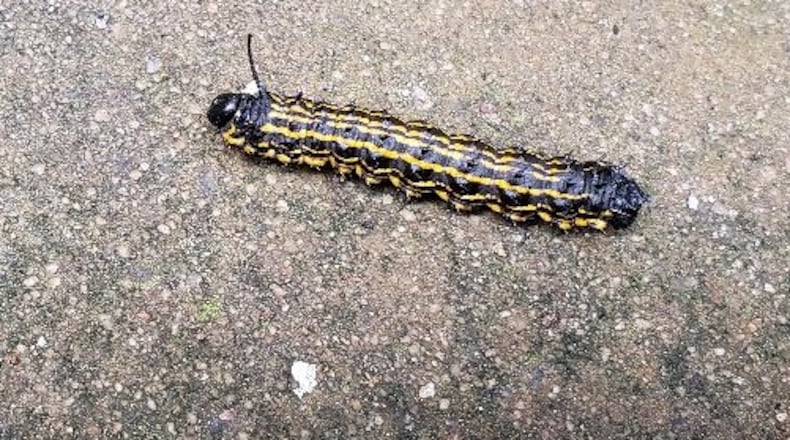Q: We have an infestation of caterpillars in our oak trees. Their droppings are covering our deck and driveway. Should we spray or just wait it out? Suzanne Freed, email
A: You have a big population of orange-striped oak worms. These caterpillars are basically a “stomach with legs,” so leaves disappear rapidly during the weeks they feed. The caterpillars are 2 to 3 inches long with yellow-orange stripes running the length of their body. Because oak worms ingest such tremendous amounts of food, one of the ways they are discovered is the thickly scattered waste pellets that fall from a tree’s foliage. On a quiet day, the pellets can be heard clattering down through the leaves and hitting the ground below. These fall caterpillars are the offspring of a moth who laid her eggs on the tree several weeks ago. Fortunately, poisons are rarely needed. Mother Nature provides a life span of only a few weeks before the caterpillar drops to the ground and pupates. Usually, there is only one generation per year. Since oak trees lose their leaves naturally in the fall, even complete defoliation does little harm.
Q: When is it too late to plant zoysia sod? Joy Toms, Morgan County
A: It would be a real gamble to lay zoysia sod now in September. Zoysia roots grow slower than other grasses, like Bermuda. Zoysia plants take around eight weeks to develop a good root system. You might choose to gamble if it’s only a small area you’re working with. However, in my experience, it would not be unusual for sod laid in September to get lots of winter kill, with many dead spots seen in spring.
Q: We lost our beautiful Japanese maple tree. It was seemingly well established. But in late spring, the leaves turned from green to brown and the tree slowly died. Can mushrooms in the soil kill a tree? Several were growing under the tree. What can we plant where the maple tree used to be? David and Martha Pierce, Cherokee County
A: There are several fungi species that live in the soil and produce mushrooms. Most of them decompose rotten roots. I think your tree received too much water over a long period and the roots slowly died. Fungi decomposed the dead roots and produced mushrooms. The fungi didn’t hurt your tree. I don’t think it’s a good idea to plant another tree in that spot. Could you put a vine-covered arbor, a big rose bush or something that is not a tree there?
Email Walter at georgiagardener@yahoo.com. Listen to his occasional garden comments on “Green and Growing with Ashley Frasca” Saturday mornings on 95.5 WSB. Visit his website, www.walterreeves.com, or join his Facebook Page at bit.ly/georgiagardener, for his latest tips.
About the Author
The Latest
Featured

